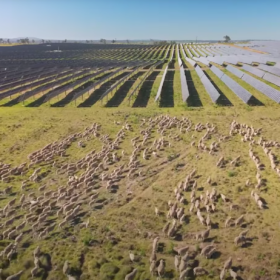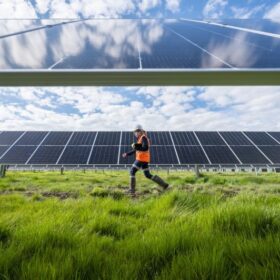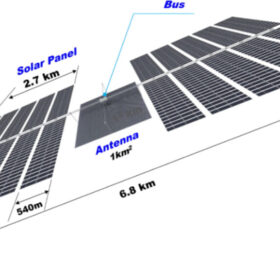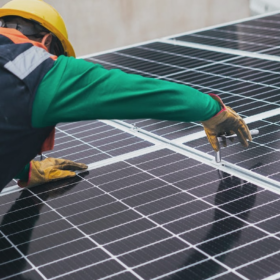Leading PV and smart energy solutions provider Trina Solar is exhibiting a module that has power output up to 700 W at the All-Energy Australia trade show in Melbourne.
“Trina Solar Vertex N-type modules are leading the industry into the PV 7.0 era,” says Edison Zhou, Trina Solar head of Australia, New Zealand and the Pacific Islands. “The solar modules at this year’s All Energy Australia show have significantly higher power output and efficiency than those displayed last year.”
The NEG21C.20 module has maximum efficiency of 22.5% and maximum power output of 700 W. The efficiency refers to how much light the module absorbs. The 700 W power is generated from the module’s frontside, and this bifacial module generates additional electricity by the rear side of the module. Bifacial modules are ideal for utility-scale projects where developers need to achieve even lower levelized cost of energy (LCOE) and lower balance of system cost (BOS).
Trina Solar modules deliver high power within a low voltage design so there can be more modules per inverter string.
The company has achieved higher power output and efficiency from the Vertex N module due to market-leading technologies incorporated into it, such as adopting the latest N-type i-TOPCon Advanced technology (cell efficiency can be as high as 26%, now reaching 25.8% in mass production), and combining N-type technology with 210mm rectangular silicon wafer (210R) cell technology, offering more feasibility, higher capacity and lower BOS for projects.
Trina Solar, along with other industry players, has also been standardising module sizes to achieve further gains in LCOE and BOS and to drive greater R&D collaboration. Standardized module sizes are referred to colloquially as ‘golden modules.’
“The solar industry is entering ‘golden era’, with the 700W Vertex N module a precursor of what is about to come,” says Zhou.
These new modules have higher power output partly because of i-TOPCon, also known as tunnel oxide passivated contact cell technology. The ultra-thin tunnelling oxide layer enhances energy conversion efficiency by helping to further contain unabsorbed light. This increases the cells’ efficiency, allowing the module to harvest more energy per unit area.
Australia’s scientific community is also part of the new ‘golden era’ in solar cell development.
“Trina Solar has a strong track record of collaborating with leading Australian universities such as the University of New South Wales, the Australia National University and Monash University on solar cell research and development,” says Zhou.
The maximum efficiency possible for silicon solar cells is, theoretically, around 29%. Trina Solar and its research partners in Australia are working to develop cells based on perovskite that capture additional light. Silicon cells combined with perovskite cells are tandem cells. The silicon cell captures the infrared part of the solar spectrum while perovskite cells capture the blue and ultraviolet spectrum.
At All Energy Australia, Trina Solar is exhibiting the Vertex S+ 450 W, a monofacial module designed for residential rooftops. This module has dual-glass allowing it to perform well in extreme heat and other challenging environments – salt spray and sand dust. The modules have a 25-year product warranty and 30-year power warranty. This product also comes in a black aesthetic version with transparent design for the more aesthetically inclined household owner.
Trina Solar is also showcasing a 610 W Vertex N bifacial module (NEG19RC.20) that has efficiency of up to 22.6%. Like with the 700 W NEG21C.20 module, this module uses N-type cells.
A key industry trend is the move towards n-type. The N-type cells optimise bifacial power generation performance and are also more durable.
The other N-type module on display is a 500 W Vertex N module (NEG18R.28), which has efficiency of up to 22.5%. The module size is 1961mm by 1134mm. The monofacial module’s enhanced durability means it comes with a 25-year product and 30-year power warranty. It also performs well in Australia’s hot and harsh climate, because it has a dual-glass design.
It is expected to be a popular choice for both residential and commercial solar installation projects in Australia. Another key trend in the Australian solar industry is the use of trackers for utility-scale projects.
Trina Solar is leading the market in truly integrated solutions, because it is the only solar module manufacturer that also makes trackers.
At All-Energy Australia, Trina Solar is promoting its new generation Vanguard 1P smart tracker. The 1P tracker system has been validated by RINA, a reputable inspection, certification and consulting multinational organization, for compliance with the Australian building codes and standards as well as for deployment in areas classified in Australia as wind region ‘c’. C stands for cyclonic areas with wind speeds of up to 238km/h.
The tracker is fully compatible with ultra-high-power modules ranging from 400 W to 700 W+. It offers unrivalled assurance around long-term performance and after-sales support as the industry’s only integrated module and tracker solution from a one-stop shop, Trina Solar.
Vanguard 1P adopts the 1P single-row design and includes technology advantages that guarantee higher reliability, more significant power generation, and optimized balance of system (BOS) cost. Vanguard 1P also unlocks more expedient construction through numerous time-saving features including split spherical bearings, lowest foundation count and one-piece TrinaClamp for module fixation. This further reduces installation time, lowering total capex and boosting internal rate of return (IRR), especially in high labor cost markets like Australia and New Zealand.
At All Energy Australia 2023, the company is promoting Trina Storage which started in China and Europe and is now expanding into Australia to meet the growing needs here for energy storage solutions.
TrinaStorage’s vertically integrated production capacity, including Trinacell, battery racks and battery cabinets, ensures high reliability and safety of its products. The industry-leading technology of self-produced cyclic cells achieves zero degradation in the first year and further extends the lifespan and power storage capacity of energy storage system.
Compatible with various PCS (power conversion system) technologies, TrinaStorage’s Elementa series of industry-leading LFP battery cabinet products can fulfill needs in different scenarios with system solution.
Zhou says: “In some parts of Australia, solar energy generation capacity may be limited due to local grid constraints and intermittent generation. The rapid growth of solar in Australia means industry players are thinking of new ways to meet the growing need for flexibility. Energy storage is a flexible solution that can provide a reliable and efficient operation of the electricity system.”
At All Energy Australia, Trina Solar is unveiling for the very first time, its new Elementa G2 4MWh energy storage system. This new product is designed specifically to cater to utility scale energy projects. Offering high energy density, it fits within a 20ft size container, which also facilitates easier transportation and logistics, bringing lower unit cost.
Trina Storage’s vertically integrated in-house manufactured cell-rack-enclosure battery technology, offers improved real-life performance with zero degradation in the first year, longer lifetime and higher efficiency. It has a thermal management system and also utilises liquid cooling so the batteries continually operate at optimal temperature range. Elementa also includes integral fire suppression and uses real-time data monitoring of key performance parameters, such as voltage and temperature, to optimise performance and ensure unequivocal fire safety, in line with all applicable Australian codes.





By submitting this form you agree to pv magazine using your data for the purposes of publishing your comment.
Your personal data will only be disclosed or otherwise transmitted to third parties for the purposes of spam filtering or if this is necessary for technical maintenance of the website. Any other transfer to third parties will not take place unless this is justified on the basis of applicable data protection regulations or if pv magazine is legally obliged to do so.
You may revoke this consent at any time with effect for the future, in which case your personal data will be deleted immediately. Otherwise, your data will be deleted if pv magazine has processed your request or the purpose of data storage is fulfilled.
Further information on data privacy can be found in our Data Protection Policy.